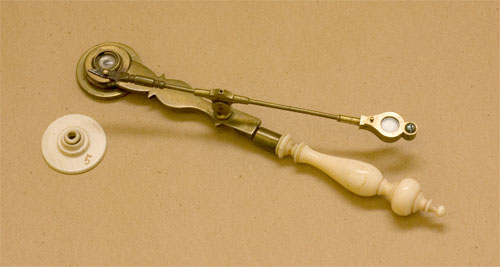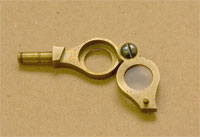 |
|||||
 |
 |
||||
 |
|||||
 |
 |
||||
Simple Microscope (No. 109 ) |
||||||
| Age: 1740–1750 Made by: unknown Made in: probably England |
||||||
 |
||||||
 |
||||||
|
Specimen live-box
|
||||||
|
Microscope No. 109 in the Golub Collection is an 18th Century brass and ivory "Compass" microscope. It is a simple magnifier with two lenses: one low-magnification lens and a second high-magnification objective (possibly not part of the set). The microscope consists of a flat brass body with a turned ivory handle. The handle screws into the body via a threaded brass cylinder soldered to the body metal. It has a single specimen holder with a forceps on one end and a pointer on the other. Inserted into the pointer end is a hinged specimen live-box. Magnification ranges from 5–10x. The instrument is approximately 17cm long. Clay and Court (1932, p. 53) describe a compass microscope that, except for its ebony handle, is identical to this one in the Golub Collection. This type of small, hand-held instrument is called a "Compass" microscope because they were often hinged, like a drafting compass, with one arm supporting the sample holder and the other the objective. By turning a focusing screw the sample arm would bring the specimen into focus. This instrument, however, is not hinged but the generic shape is that of a "Compass microscope". Microscope featured 09/08 |
||||||